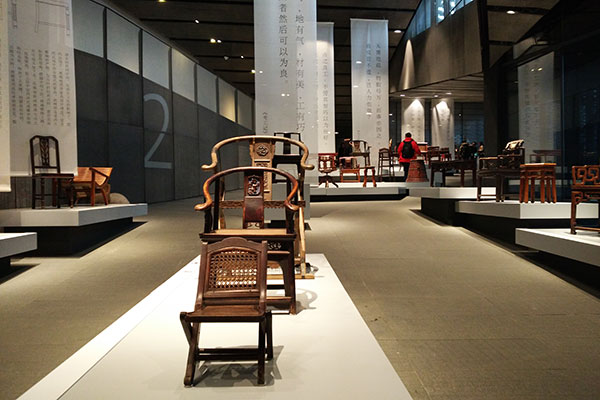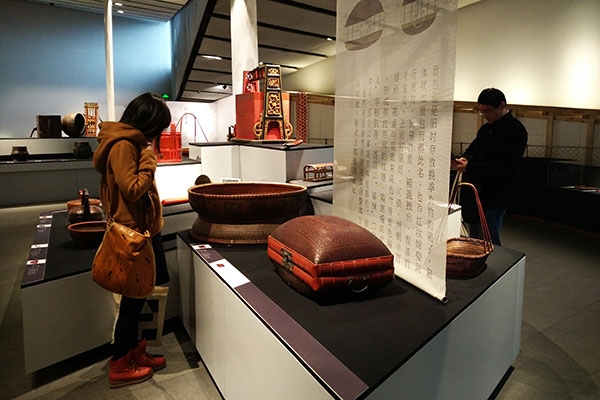The geographic area of Jiangnan, which is to the south of Yangtze River, figures in many Chinese novels and history books.
The Hangzhou-based China Academy of Art, which is a government school in the provincial capital of Zhejiang, is now offering more on the area’s lifestyle by way of a folk crafts museum on its premises. The museum that combines old Jiangnan aesthetics with modern design was opened in September.
Kengo Kuma, a Japanese architect, mixed elements of traditional houses and contemporary styles to shape the space. The 2,000-square-meter exhibition hall, for example, resembles a local village. The way in which Jiangnan’s earlier residents lived are visible as one just enters the museum.
The World of Crafts in the Countryside of Jiangnan is the museum’s exhibition.
Museum director Hang Jian says he didn’t select the exhibits based on their value as cultural relics alone but also by judging their designs. It is worth reminding society to “pay more attention to traditional craftsmanship and lifestyles”, he adds. The museum is among the country’s largest such attempts at preserving folk crafts.
“A museum usually shows the finest pieces it collects to reflect the best techniques in preservation,” Jin Xiaoyi, co-curator of the ongoing exhibition, says of the daily-use items shown here, in a marked departure from approaches of other museums on intangible cultural heritage that emphasize the longevity and complexities of such processes.

The exhibition of the Hangzhou-based China Academy of Art’s folk crafts museum features daily-use items made by grassroots artisans in the southern reaches of the Yangtze River.[Wang Kaihao / China Daily]
The idea behind such displays is to celebrate grassroots artisans “who are closer to ordinary people” rather that just having the works of “top masters with comfortable lives”, she says.
Hundreds of Chairs with Hundreds of Forms, a part of the exhibition, has chairs with various functions collected from local communities.
“Chairs are an important component of industrial design and reflect people’s lives,” Jin says. “Their simple shapes actually contain complex design theories and show an artisan’s skills.”
Following on the same lines is another part of the exhibition called Study the Phenomenon of Nature, which includes some 100 old window panes. And while they don’t come with delicate wood carvings, their simple structures reflect traditional styles and their potential usefulness in the modern world. Such window panes are rarely seen in today’s China.
“Children now don’t have the luxury of being cared for in such a manner,” Jin tells China Daily, while pointing at some delicate chairs for children on show.
In another section-Tao in Daily Use-a dazzling kaleidoscope of baskets, tools, dinnerware and other items are presented to depict a story of simplicity. Many of the exhibits here appear closer to contemporary tastes even if they belonged to the early 20th century or earlier.
“When today’s Chinese talk about gadgets with delicate designs, they often think of Japan,” Jin says. “I want them to know we also once had many such designs. But war, social upheaval and other reasons led them fade away from society before we noticed.”
There are two key ways to develop a folk craft: to preserve as it was or to mix it with modern design.
“We prefer the second as we want to explore the possibility of revitalizing their spirit in our industrial design in the future,” she says, adding that while she doesn’t expect the old pieces to be used daily, she feels the ancient wisdom hidden in them may be of value to present-day product designers.
“Modern people are used to geometric patterns, but what will happen if we reintroduce organic designs to our industrial products?” she asks, showing an exhibited set of tweezers shaped like a swallow as an example.
Zhao Yi, a professor at Shandong University of Art & Design, says: “Chinese folk crafts were known for an admiration of nature and for following simple, delicate styles.”
But the appreciation of folk crafts fell amid the country’s many rapid changes in the past few decades.
“When a taste for flamboyance becomes a fad, it is time to get back to tradition,” Zhao says.
Maybe the Jiangnan style will help in the revival.
Fang Xiaofeng, a professor of decoration and design at Tsinghua University, says: “In China, folk crafts were on the opposite side of royal craftsmanship ... a rather inferior position. But no royal art could be nurtured without the basis of folk crafts.”
However, while such crafts are being remembered today, just putting them on show at museums isn’t likely to revive their fortunes, he says.
As for Zhao, he says: “They can be sources of inspiration for modern design. They should create something we can buy from the supermarkets rather than be turned into luxury items.”
If you go
9 am-4 pm (Mondays closed). Folk Crafts Museum, China Academy of Art (Xiangshan campus), 352 Xiangshan Road, Xihu district, Hangzhou, Zhejiang province. Free entrance. The opening exhibition is to run through May.


